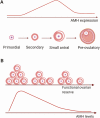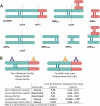Anti-Müllerian Hormone and Ovarian Reserve: Update on Assessing Ovarian Function
- PMID: 32770239
- PMCID: PMC7486884
- DOI: 10.1210/clinem/dgaa513
Anti-Müllerian Hormone and Ovarian Reserve: Update on Assessing Ovarian Function
Abstract
Context: Anti-müllerian hormone (AMH) is produced by granulosa cells of small, growing follicles in the ovary. Serum AMH levels strongly correlate with the number of growing follicles, and therefore AMH has received increasing attention as a marker for ovarian reserve. This review summarizes recent findings and limitations in the application of serum AMH in ovarian reserve assessment.
Evidence acquisition: A PubMed search was conducted to find recent literature on the measurements and use of serum AMH as a marker for ovarian reserve.
Evidence synthesis: Serum AMH levels are measured to assess the "functional ovarian reserve," a term that is preferred over "ovarian reserve," since AMH levels reflect the pool of growing follicles that potentially can ovulate. Serum AMH levels are used in individualized follicle-stimulating hormone dosing protocols and may predict the risk of poor response or ovarian hyperstimulation syndrome but has limited value in predicting ongoing pregnancy. Serum AMH levels are studied to predict natural or disease-related age of menopause. Studies show that the age-dependent decline rates of AMH vary among women. The generalized implementation of serum AMH measurement has also led to an increase in diagnostic assays, including automated assays. However, direct comparison of results remains problematic.
Conclusion: Serum AMH remains the preferred ovarian reserve marker. However, the lack of an international standard for AMH limits comparison between AMH assays. Furthermore, little is known about endogenous and exogenous factors that influence serum AMH levels, which limits proper interpretation of AMH values in a clinical setting.
Keywords: AMH; AMH assays; fertility prediction; functional ovarian reserve; menopause; ovarian reserve.
© Endocrine Society 2020.
Figures


References
-
- Jeppesen JV, Anderson RA, Kelsey TW, et al. Which follicles make the most anti-mullerian hormone in humans? Evidence for an abrupt decline in AMH production at the time of follicle selection. Mol Hum Reprod. 2013;19(8):519-527. - PubMed
-
- te Velde ER, Scheffer GJ, Dorland M, Broekmans FJ, Fauser BC. Developmental and endocrine aspects of normal ovarian aging. Mol Cell Endocrinol. 1998;145(1-2):67-73. - PubMed
-
- Dewailly D, Andersen CY, Balen A, et al. The physiology and clinical utility of anti-mullerian hormone in women. Hum Reprod Update. 2014;20(3):370-385. - PubMed
-
- Findlay JK, Hutt KJ, Hickey M, Anderson RA. What is the “ovarian reserve”? Fertil Steril. 2015;103(3):628-630. - PubMed

